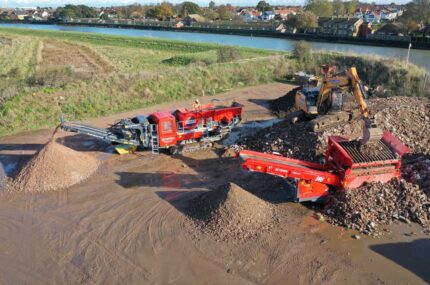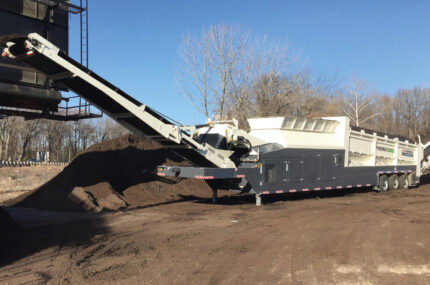Collard Group recycling plants raise the bar in Reading.
Collard Group’s recycling division has installed a state-of-the-art Terex recycling system at their Reading facility that will increase the amount of waste they can segregate to be recycled and create job opportunities in the area.
Rob Collard’s name is synonymous with motor racing and in particular the British Touring Car Championships. An independent cup winner in 2003, he returned to the championship full time in 2008 seeing him compete at the highest levels in this sport.
What many people don’t realise is that Rob also runs a very successful demolition business, backed by their own recycling plants, and has done so since 1995. Working in and around waste and haulage since he was a boy, growing up on his fathers’ farm and working with him full time in his waste business, before stepping out as a mobile truck mechanic and setting up as an owner operator with a truck and backhoe loader for Costain on the construction of the M3 motorway.
Since then, the company has grown and diversified into one of the largest privately owned national demolition contractors and waste management businesses with over 400 employees and turning over more than £70m.
Operating nine recycling plants across five counties, Collard processes over a million tonnes of waste per annum and has recently taken a huge step forward in the processing of waste products in a bid to segregate and recover a higher percentage of the material we throw away on a daily basis.
Collard’s Reading facility has just been upgraded with a state-of-the-art and world first, waste processing plant sourced through Molson Green and manufactured by Terex Recycling Systems, designed to increase the ability to segregate materials in a faster, more efficient manner. Lee Phelan has been the Group’s Managing Director for the waste and recycling division for the past six years and has hailed the installation of the Terex recycling system as a huge step forward for both the company and the wider environment; “We are great believers here at Collard in the circular economy and have a drive to deliver just that for ourselves, our customers, and the wider environment. We have been recycling materials for over two decades, formally, in basic terms, but as technologies have advanced, we have invested heavily in our recycling plants to ensure we consistently meet a 98% landfill diversion rate across the group.”
The new Terex recycling system has been designed to fit into a combination of an existing shed and a new shed built to increase the company’s capability at the site. The detailed planning and design of the plant commenced 12 months before any construction works commenced, with engineering teams from Molson and Terex speaking with Rob, Lee and the team to understand their requirements going forward. “There was a lot of going backwards and forwards to get the specification and designs of our Terex recycling system just right.” Lee commented. “The result is a plant that not only exceeds our current throughput requirements, which has future-proofed us, but is also capable of segregating material even more productively and accurately than we have done before. While part of our requirement was the increased segregation of material, we also wanted to reduce the amount of labour-intensive segregation we have undertaken in the past.” With the details and specification of the plant agreed, Terex commenced the build of the plant with the various parts of the plant being delivered in November 2022 and the build process supervised by the Molson Senior Operations Manager, Carl Longhorne, commencing shortly after. With the original waste sorting plant still in operation during the build process, the Molson engineering team had to work around the ongoing Collard operations, and they did so successfully delivering a completed plant ready for work by early February. “It was a tight squeeze at some points with the constraints of the building and the recycling work still going on.” Carl commented. “But both parties had an end goal to get the plant up and running and we worked together to deliver just that.”
Pre-sorting of incoming material with a 13-tonne excavator and selector grab takes out some of the larger items of waste before a dedicated material handler loads the Terex recycling system with the remaining material. A conveyor system transports the material to an inclined Spalek screen box where the various grades of material start to be separated. From the Spalek screen material is diverted in two directions with 100-300mm fragments heading to a state-of-the-art brightly lit and heated picking station where operatives pick out wood, paper and card, plastics, metals, and general waste with the remaining materials such as ferrous metals being taken out with an over band magnet, lights separated with a blower into a cage and heavies sent to a bay outside the shed for onward crushing. Smaller materials separated at the Spalek are split into three sizes; 0-10mm, 10-50mm and 50mm-100mm. These streams pass through an over band magnet to remove any ferrous metals with materials classed as fines dropping straight into their own dedicated bay. A pair of Westeria air separators remove the lights with the final quality control station taking out and smaller items of wood and other materials. Finally, an eddy current separator removes any non-ferrous metals with heavies such as tie, brick and stone going to another heavy’s bay. The plant gives Collard up to 10 different end products, all of which can be recycled further reducing the environmental impact of using new materials. “We are using some of the heavy materials, once they are processed to add into our quality assured, BSI approved concrete.” Lee commented. “We have undertaken several projects where our demolition teams have cleared a site, the material has gone through our recycling plants, creating high quality recycled aggregates, before it has gone back into the new development in our concrete.”
Other materials segregated by the recycling plants are sent out to a variety sources both in the UK and abroad for final processing, ensuring Collard meet their desire of providing a circular economy for a wide range of different products. Not only has the installation of the new Terex recycling system increased the range of materials segregated and recycled, but there has also been a positive impact for the local economy, with Collard adding a further six jobs since its introduction. “One would think that the increased automatic segregation of materials would reduce the amount of labour required to complete the tasks.” Lee comments. “The fact that we have now increased the final product, along with increasing our volume of material, has meant that we have had the opportunity to offer employment to anyone in the locality.” Not content with recycling more materials, the entire roof area catches rainwater and stores it ready for use in the misting systems used inside the building to ensure dusts and smells are kept to a minimum.
The huge environmental impact on the waste produced from our daily lives is recorded by the team at Collard with detailed information collated and used to calculate the reduction in carbon impact their recycling operations are having on the areas in which they operate.
With the Terex recycling system installed and working as expected, we asked Lee what the driver was for choosing the Terex brand. “We have several waste segregation unit operating at our recycling plants from other manufacturers, but it was the level of detail Molson went into that made us look at the Terex recycling system. It’s a well-known and respected brand in the crushing and screening industry and with that heritage and pedigree, along with the knowledgeable staff, it was a relatively easy decision to make.”





